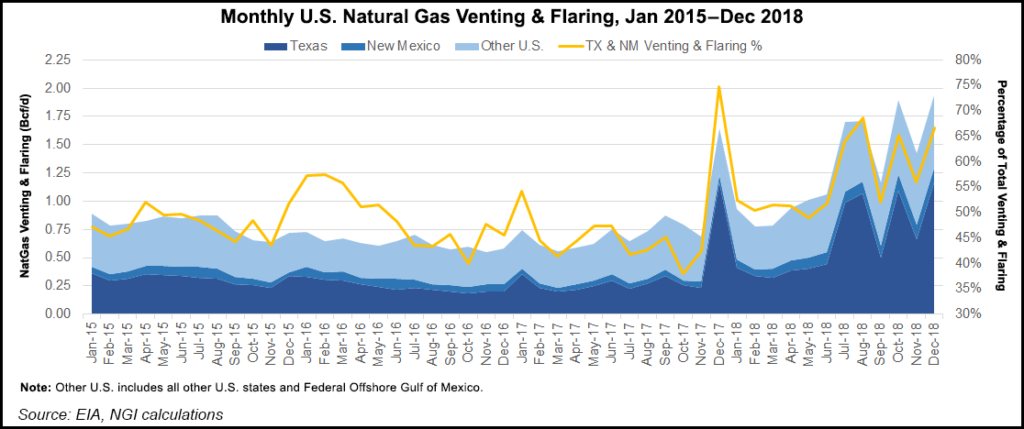Shale Daily | E&P | NGI All News Access | NGI The Weekly Gas Market Report | Permian Basin
Natural Gas Flaring Remains ‘Undoubtedly’ Very High in Permian Basin, Says Rystad
The volume of waste natural gas that is flared or vented at the wellhead in the Permian Basin tripled between early 2017 and the fourth quarter of 2018 and has been range bound since then between 550 MMcf/d and 750 MMcf/d, “undoubtedly a very high volume,” according to analysts at Rystad Energy.

The dominant share of that flaring comes from the Permian’s Delaware sub-basin in Texas, which recently has accounted for about 40% of the total, down from the 55-60% share it held in 2016-2017, according to a report from Rystad. Still, flaring intensity in the Texas portion of the sub-basin has been stable since 2017 at 4.3-5.2%.
Flaring in the Delaware of New Mexico declined from 130 MMcf/d in 4Q2018 to about 100 MMcf/d in 3Q2019, with flaring intensity tumbling to 2.8% from 4.6% over the same period.
In the Midland North, Rystad saw a spike in flaring intensity between 4Q2018 and 1Q2019 due to infrastructure outages. “Yet its flaring intensity remains at or above the level observed in Delaware Texas, representing a vast contrast to the exceptionally low flaring intensity seen in Midland North prior to 2018,” Rystad said. “This negative trend is associated with increased activity levels in some of the less developed regions in Midland North,” including Howard and Martin counties in Texas.
Rystad also reported a significant increase in flaring intensity in Midland South, where flaring of gross gas reportedly climbed to 4% in 3Q2019 from 2.7% in the previous quarter.
Rystad’s analysis comes in the wake of an Energy Information Administration (EIA) report that found the volume of U.S. natural gas vented and flared reached a record high average of 1.28 Bcf/d in 2018, with Texas and North Dakota accounting for 82% of the total. The percentage of domestic gas vented and flared increased in 2018 to 1.25% of gross withdrawals, compared with 0.84% in 2017. Texas and North Dakota accounted for 51% and 31%, respectively, of total U.S. vented and flared natural gas, EIA said.
Looking forward, planned oil and natural gas projects in the United States made possible by the unconventional oil and natural gas drilling revolution could release up to 227 million tons of additional greenhouse gas pollution by the end of 2025, generated by a variety of sources, including West Texas venting and flaring, according to the Environmental Integrity Project.
© 2024 Natural Gas Intelligence. All rights reserved.
ISSN © 2577-9877 | ISSN © 1532-1266 | ISSN © 2158-8023 |
